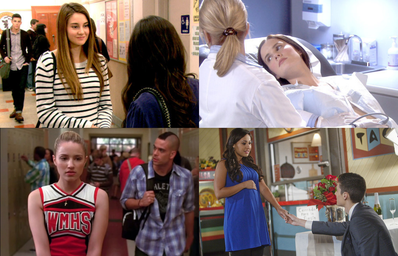My frustration started on your average Saturday night, when it suddenly hit me how TV shows romanticize teen pregnancy — often to their teenage viewers. I was watching Make It Or Break It, a nostalgic TV show that I used to binge-watch with my sister at the age of 10. Following four gymnasts on their way to the Olympics, there’s no shortage of teen drama, cool gymnastics tricks, and love triangles.
I was thoroughly enjoying my rewatch — that is, until Emily, one of the main characters, has sex for the first time and boom! She gets pregnant. This becomes arguably the biggest scandal in the entire show: How will she fulfill her Olympic dream with a baby on the way? How will she tell her newfound boyfriend? Will this be the end of her gymnastics career?
Spoiler alert: Emily ends up leaving the show entirely and has the baby at 18 years old (which we can only assume, because neither the birth nor the aftermath is shown). She waves goodbye to her past, her friends, and ultimately, her dream. In return, she starts a new life with her boyfriend and their new baby.
This story is not always accurate. Firstly, in MIOBI, protection is depicted as a foreign object that characters don’t even consider. But even if Emily and her boyfriend had used protection and it failed, Emily’s teen pregnancy scandal still doesn’t tell the whole story, which is detrimental to the show’s young audience. It’s essential to understand the consequences that can arise from having a baby as a teen, and that the alternative can be a totally safe and viable option. There’s rarely any riding into the sunset holding hands with your partner and a beautiful baby bump, like those TikToks you see. In reality, teen pregnancy can be a lot messier.
The “Happily Ever After” outlook leaves out important details.
Think of it this way: Ending the teen pregnancy story right when they have the baby is like ending a movie right as the climax begins. There are so many challenges that come with having a baby as a teenager, and it’s time TV shows began discussing them accurately.
First of all, the vast majority of TV shows ignore the issue of money. In Make It Or Break It, Emily is poor, yet she finds no issues in moving away from home with a baby on the way. But in a lot of cases, particularly when parents don’t have the means or will to help out, money is hard to come by for two unemployed teenagers with a baby. As South Carolina research center Fact Forward reports, “Almost half of all teen mothers [begin] receiving welfare within five years of the birth of their first child,” and approximately “52% of all mothers on welfare had their first child as a teenager.”
Career-wise, teen pregnancy introduces a set of problems that are rarely mentioned in TV shows. According to a study by StayTeen, teen pregnancy is the number one cause for female high school dropouts, and over half of all teen moms don’t graduate from high school. StayTeen also reports that under 2% of teen mothers graduate from college by the time they’re 30. In plenty of cases, teen pregnancy is a hindrance to finding a stable career — but it seems that this fact is rarely illustrated in today’s TV shows.
For example, in Glee, though Quinn’s ability to overcome her teen pregnancy scandal is admirable, her story is far from realistic. After quickly finding a competent and loving woman to adopt her baby, Quinn’s struggle is barely mentioned. She proceeds to resume her happy, normal life, and seems to be unfazed by the pregnancy — in fact, Quinn ends up studying at Yale. And although this is quite the comeback for Quinn, it just doesn’t reflect the stories of most teen mothers.
The Secret Life of the American Teenager is also guilty of glorifying teen pregnancy — in this show, the commitment of having a child and being pregnant is glossed over. Amy succeeds in school, has a busy social life, and enjoys extracurricular activities with little mention of her child at home. As the New York Times stated in 2008, Secret Life “means well but could not have done worse” at trivializing teen pregnancy.
“Teenage mothers are at a higher risk for postpartum depression,” Ariel Dalfen, head of the Perinatal Mental Health program at Mount Sinai Hospital in Toronto, tells Her Campus. “These women often end up raising the child alone, and this has a great impact on their education, career aspirations, relationships, and overall well being.” TV shows often neglect to share these issues, along with the growing probability that the parents’ relationship will end.
Now, all of these complications don’t mean that teen parents can’t be happy — you can definitely overcome these challenges and live a happy life. However, these are still things that TV shows often leave out — and whether intentional or not, these shows end up sending the wrong messages to their audiences.
The characters ignore the alternative option, contributing to stigma against abortion.
Few TV shows even mention abortion, like it’s a dirty word. It’s practically unheard of for a character in a TV show to have an unwanted pregnancy, have an abortion, and return to their normal life, even though this is what happens to plenty of unwanted pregnancies nowadays.
In fact, according to a study in The Lancet Global Health journal, 61% — almost two thirds — of unplanned pregnancies from 2015-2019 resulted in an abortion. Note that this statistic includes both adults and teenagers, but regardless, it demonstrates that abortions are a common choice. So why do TV characters seem to never consider having an abortion? Is it because the writers are afraid of backlash (ahem, Desperate Housewives)? Or perhaps they find it to be an underwhelming ending to a climax as shocking as an unintended pregnancy?
Euphoria and Sex Education seem to be two of the only shows currently on air that tackle this route. These shows are two examples that display that a teen pregnancy can safely end in an abortion, and the teenagers can quickly return to their lives; this reflects the stories of many teenagers today. However, as time goes on, it can become harder for women to undergo the same experiences as the characters in these two shows — because in today’s society, abortions are becoming less of a right and more of a privilege.
With Roe V. Wade in danger of being repealed, we must consider the effects of these TV shows on the women whose right to control their own bodies is being taken away from them — and on our society as a whole. For women in states with restrictive laws or women who don’t have the financial means or parental approval needed to travel somewhere else, having a safe abortion may not be possible soon. In these cases, having an abortion can be just as unrealistic as having the baby for many young women — which is also an important factor to represent on TV shows.
It would be moving and insightful — as well as educational — to see a TV show where a character wants to have an abortion but cannot because of the laws in place. Providing an accurate, timely portrayal of the effects of abortion bans would teach people of all ages and genders that abortion is a basic human right that, without it, can place negative impacts on a woman’s life forever. And without this kind of representation, women’s stories lack the attention needed in order to provoke change.
These plotlines affect teen moms in the real world.
It’s important to consider the opinions of today’s teen moms. In a 2016 study, 26 women were asked about the portrayal of teen pregnancy in TV reality programs (such as Teen Mom and 16 and Pregnant). The teen mothers expressed that the “representations [glamorize] teenage pregnancy while failing to capture other realities, such as financial hardship.” These discrepancies have led to “negative media-fuelled public views,” because people today just don’t understand how difficult teen pregnancy can be. Even when the stories are absolutely true, as opposed to those completely decided by the writer’s room, TV shows still miss an important part of the story. Both types of TV rely on the need for a dramatic plot line with a quick, seamless happy ending — but it’s important to not gloss over the hardships of teen pregnancy.
But why is it important for TV shows to portray an accurate story? It’s simple: Representation matters. Not only is it important for teen mothers to feel like they’re being heard, but it’s also essential to educate our society on the hardships that can come with getting pregnant as a teenager. Displaying misleading stories leads us to believe that hey, maybe teen pregnancy isn’t as challenging as we think, thus providing us with a wrongful image of teen pregnancy that can leave us with less empathy toward actual teen moms and a more blasé attitude toward unprotected teenage sex.
Furthermore, this lack of representation may even contribute to the stigma against abortion. By having characters quickly wave off abortion as if it’s a bad word or harmful option, we fail to teach youth that having an abortion is nothing to be ashamed or scared of — it’s actually a basic human right that provides women with the freedom to control their own bodies. If we want our society to understand the realities of teen pregnancy, representation of accurate stories is essential.
The things we watch make great impressions on us, and it’s therefore essential that we illustrate these conflicts in an accurate way. This means discussing the complications that come along with teen pregnancy and explaining that abortion can and should be a common and safe option.


